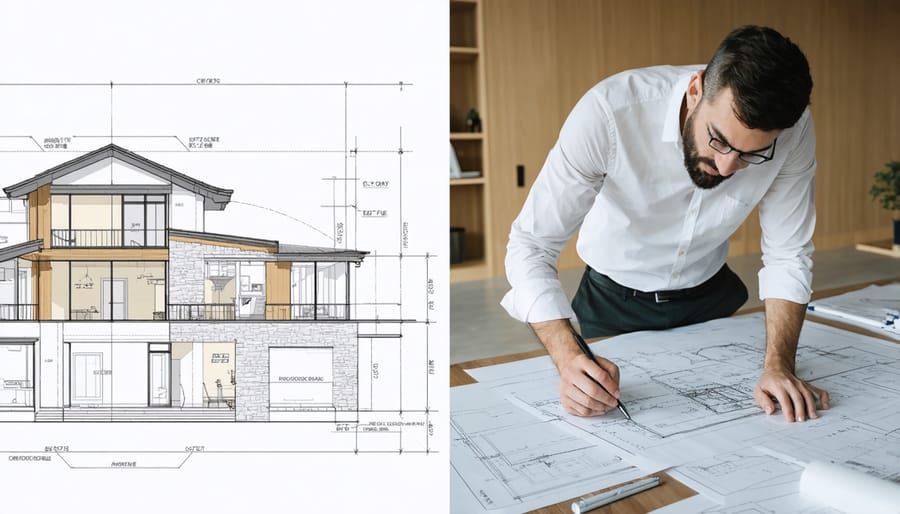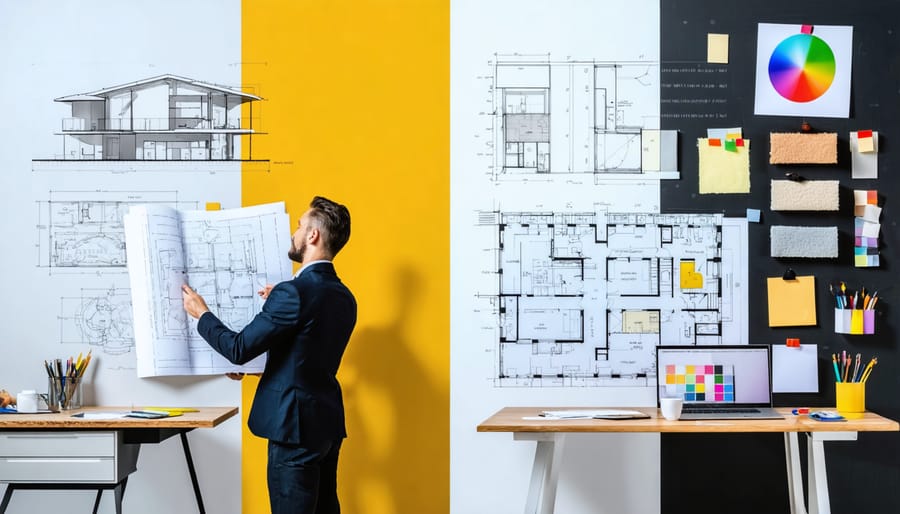While both architects and interior designers shape our built environment, the fundamental distinction between these professions extends far beyond aesthetic choices. Architecture encompasses the structural integrity, spatial organization, and exterior envelope of buildings, focusing on how structures interact with their surroundings and meet functional requirements. Interior design, conversely, specializes in optimizing internal spaces through careful selection of finishes, furniture, and ambient elements to enhance human experience and functionality.
This critical differentiation affects project scope, legal responsibilities, and required expertise. Architects must consider building codes, safety regulations, and engineering principles while coordinating with multiple stakeholders to ensure structural soundness. Interior designers concentrate on space planning, material specifications, and creating environments that align with client preferences while adhering to safety and accessibility standards.
Understanding these distinctions is crucial for project success and professional collaboration. Whether renovating an existing space or constructing a new building, recognizing the unique contributions of each discipline helps clients make informed decisions about which professional to engage. This article examines the key differences between architecture and interior design, from educational requirements and licensing to project roles and creative approaches, providing clarity for industry professionals and clients alike.

Core Professional Responsibilities
Architectural Scope and Authority
Architects operate with broad authority and responsibility in construction projects, serving as the primary design professionals responsible for the building’s overall conception, structural integrity, and compliance with building codes. Their scope encompasses crucial elements such as foundation design, load-bearing calculations, and the integration of advanced building systems.
Unlike interior designers, architects must ensure that all aspects of the building meet local zoning requirements, safety standards, and accessibility regulations. They coordinate with structural engineers, mechanical engineers, and other specialists to develop comprehensive building solutions that address both form and function. Their responsibilities include creating detailed construction documents, overseeing site planning, and managing building envelope specifications.
Furthermore, architects hold legal liability for the building’s structural safety and code compliance. They must maintain professional licensure, which requires extensive education, practical experience, and passing rigorous examinations. This heightened level of responsibility reflects in their authority to approve major structural modifications and their obligation to ensure that all design decisions support the building’s integrity and performance.
Their scope also extends to sustainable design principles, energy efficiency considerations, and long-term building performance, making them essential stakeholders in the construction industry’s evolution toward more sustainable practices.
Interior Design Parameters
Interior designers specialize in transforming interior spaces through meticulous space planning, material selection, and aesthetic considerations. Their expertise encompasses the manipulation of spatial relationships, focusing on how occupants interact with and move through interior environments. Unlike architects who primarily deal with structural elements, interior designers concentrate on optimizing functionality while creating visually appealing spaces that reflect the client’s vision and lifestyle needs.
The parameters that guide interior design decisions include spatial flow, lighting design, color psychology, and the integration of innovative building materials within existing structures. Interior designers must consider factors such as furniture placement, traffic patterns, acoustic requirements, and the psychological impact of design elements on occupants.
A critical aspect of interior design parameters involves balancing form and function through:
– Strategic space planning that maximizes square footage utilization
– Selection of appropriate finishes, textures, and materials
– Implementation of effective lighting solutions
– Integration of storage solutions and built-in elements
– Coordination of color schemes and decorative elements
– Consideration of ergonomics and accessibility requirements
These parameters require interior designers to possess deep knowledge of current design trends, material properties, and human behavioral patterns while maintaining compliance with building codes and safety regulations specific to interior spaces.
Educational and Licensing Requirements

Architectural Qualifications
Architectural qualifications represent one of the most rigorous professional paths in the construction industry. Architects must complete a 5-year professional degree from an accredited architecture program, typically resulting in a Bachelor of Architecture (B.Arch) or Master of Architecture (M.Arch) degree. The curriculum encompasses structural engineering, building systems, environmental design, and construction documentation.
Following graduation, architects must complete a comprehensive internship program, typically lasting three years (3,740 hours), known as the Architectural Experience Program (AXP). This practical training covers six essential practice areas, including project management, practice management, and construction evaluation.
Licensing requirements mandate passing all divisions of the Architect Registration Examination (ARE), a multi-part test evaluating competency in various aspects of architectural practice. Additionally, architects must obtain state licensure in each jurisdiction where they practice, with requirements varying by state.
Continuing education is mandatory for licensed architects, with most states requiring 12-18 learning units annually. These units must include topics related to health, safety, and welfare (HSW). Professional organizations like the American Institute of Architects (AIA) provide structured pathways for ongoing education and professional development, ensuring architects maintain current knowledge of building codes, sustainability practices, and emerging technologies.
Interior Design Credentials
Interior design professionals can pursue several educational and certification pathways to establish their credentials. The minimum educational requirement typically includes a bachelor’s degree in interior design from an accredited institution, which takes four years to complete. These programs combine theoretical knowledge with practical skills in space planning, materials, lighting, and design principles.
The most recognized professional certification is the National Council for Interior Design Qualification (NCIDQ) examination, which requires a combination of education and work experience. Candidates must complete at least six years of combined education and experience before qualifying to take the exam. The NCIDQ certification demonstrates proficiency in health, safety, and welfare aspects of interior design.
State-specific requirements vary, with some jurisdictions requiring interior designers to be licensed or registered. Professional organizations like the American Society of Interior Designers (ASID) and the International Interior Design Association (IIDA) offer additional certifications and continuing education opportunities. These credentials validate expertise in specialized areas such as sustainable design, healthcare facilities, or commercial spaces.
Maintaining credentials requires ongoing professional development through continuing education units (CEUs), ensuring interior designers stay current with industry standards, building codes, and emerging technologies.
Project Involvement and Collaboration
Project Timeline Integration
The integration of architects and interior designers into a construction project follows a distinct timeline that maximizes project efficiency and ensures cohesive results. Architects typically enter the project during its earliest conceptual stages, often before any formal design work begins. Their involvement is crucial in establishing the fundamental structure, spatial relationships, and regulatory compliance framework that will guide the entire project.
During the design development process, interior designers usually join the team once the basic architectural framework is established, typically around the schematic design phase. This timing allows them to collaborate effectively with architects while the space planning is still flexible enough to accommodate interior design considerations.
Both professionals maintain ongoing roles throughout the project, but their involvement intensity varies at different stages. Architects’ participation peaks during the initial planning and structural development phases, gradually reducing to oversight roles during interior completion. Conversely, interior designers’ involvement intensifies as the project progresses toward completion, with their most significant input during the finishing stages.
Critical collaboration points occur during material selection, lighting design, and spatial planning modifications. This overlapping timeline ensures that both architectural integrity and interior functionality are maintained throughout the project’s duration, resulting in a harmonious final product that meets both technical requirements and aesthetic goals.
Collaborative Dynamics
The relationship between architects and interior designers exemplifies the essence of successful project delivery in the built environment. While each profession maintains distinct responsibilities, their collaborative synergy creates spaces that are both structurally sound and aesthetically cohesive. This partnership typically begins in the early planning stages, where architects establish the fundamental framework while interior designers contribute insights about spatial flow, functionality, and user experience.
Effective collaboration manifests through regular coordination meetings, shared design development sessions, and integrated problem-solving approaches. Architects provide crucial structural parameters and building systems information that interior designers must consider when planning layouts and selecting materials. Conversely, interior designers offer valuable input about space utilization, lighting requirements, and finish selections that can influence architectural decisions.
Modern construction projects benefit from Building Information Modeling (BIM) platforms, which enable real-time collaboration between these professionals. This technological integration allows for early detection of potential conflicts and seamless coordination of design elements. The result is a more efficient project workflow and reduced likelihood of costly modifications during construction.
Case studies consistently demonstrate that projects achieving the highest levels of success are those where architects and interior designers maintain open communication channels and mutual respect for each other’s expertise. This collaborative approach ensures that the final built environment delivers both structural integrity and interior functionality while meeting the client’s aesthetic vision and practical requirements.

Legal and Regulatory Distinctions
Architectural Liability
Architects bear significant legal responsibilities that extend far beyond aesthetic considerations. In most jurisdictions, they are legally accountable for ensuring their designs meet building codes, safety regulations, and structural integrity requirements. This liability often continues for several years after project completion, with architects potentially facing professional negligence claims if design defects emerge.
Unlike interior designers, architects must carry substantial professional liability insurance, often in the millions of dollars, to protect against claims related to design errors, structural failures, or safety issues. They are responsible for signing and sealing construction documents, which becomes a legal warranty of the design’s compliance with applicable codes and standards.
The architect’s liability typically encompasses structural stability, fire safety, accessibility compliance, and emergency egress requirements. They must ensure their designs protect public health, safety, and welfare – a legal obligation that doesn’t generally apply to interior designers. This responsibility extends to coordinating with engineering professionals and ensuring all building systems work together safely and efficiently.
When issues arise, architects can face legal action from multiple parties, including clients, contractors, and building occupants. Professional errors can result in disciplinary actions from licensing boards, civil lawsuits, and in extreme cases, criminal charges if negligence leads to injury or loss of life. This heightened liability explains why architectural services often command higher fees and require more extensive documentation than interior design services.
Interior Design Regulations
Interior designers operate within specific regulatory frameworks that vary by jurisdiction, with licensing requirements enforced in many states to protect public safety and ensure professional competence. These regulations typically define the scope of interior design practice, which includes space planning, material selection, and aesthetic considerations within existing structures.
Licensed interior designers can generally submit drawings for permits related to non-structural interior elements, such as furniture layouts, finish specifications, and lighting plans. However, they must collaborate with architects or engineers when their work impacts load-bearing elements, egress routes, or building systems.
Most jurisdictions require interior designers to demonstrate their competency through a combination of education, experience, and examination. The National Council for Interior Design Qualification (NCIDQ) certification serves as the industry standard, requiring candidates to complete a minimum of six years combined education and supervised work experience before qualifying for the examination.
Professional liability considerations also shape interior design practice. Designers must maintain appropriate insurance coverage and carefully document their work to protect themselves and their clients. They are responsible for ensuring their designs comply with building codes, accessibility requirements, and health and safety regulations.
Understanding these regulatory boundaries is crucial for both designers and clients, as it defines the extent of services that can be legally provided without architectural oversight. This framework helps maintain professional standards while ensuring public safety in the built environment.
While architecture and interior design are distinct disciplines, their synergistic relationship is crucial for creating successful built environments. Architects focus on the fundamental structure, spatial planning, and external aesthetics of buildings, ensuring they are safe, functional, and compliant with building codes. Interior designers, meanwhile, specialize in optimizing internal spaces, selecting finishes, and creating environments that enhance user experience and functionality.
The key differences between these professions lie in their scope, educational requirements, and regulatory frameworks. Architects typically require more extensive formal education and licensure, as they bear responsibility for the building’s structural integrity and safety. Interior designers, while also professionally trained, focus more on the aesthetic and functional aspects of interior spaces, often requiring certification rather than licensure in many jurisdictions.
However, the most successful construction projects emerge when both professionals collaborate effectively. Architects provide the essential framework and structure within which interior designers can create compelling spaces. This partnership ensures that technical requirements align seamlessly with aesthetic goals, resulting in buildings that are not only structurally sound but also beautifully appointed and highly functional.
For construction industry stakeholders, understanding these distinctions is vital for project planning and execution. Each profession brings unique expertise and perspective to the table, and recognizing their complementary roles helps in assembling the right team for specific project requirements. As the built environment becomes increasingly complex, the combined expertise of architects and interior designers becomes even more crucial in delivering projects that meet both technical specifications and user expectations.

